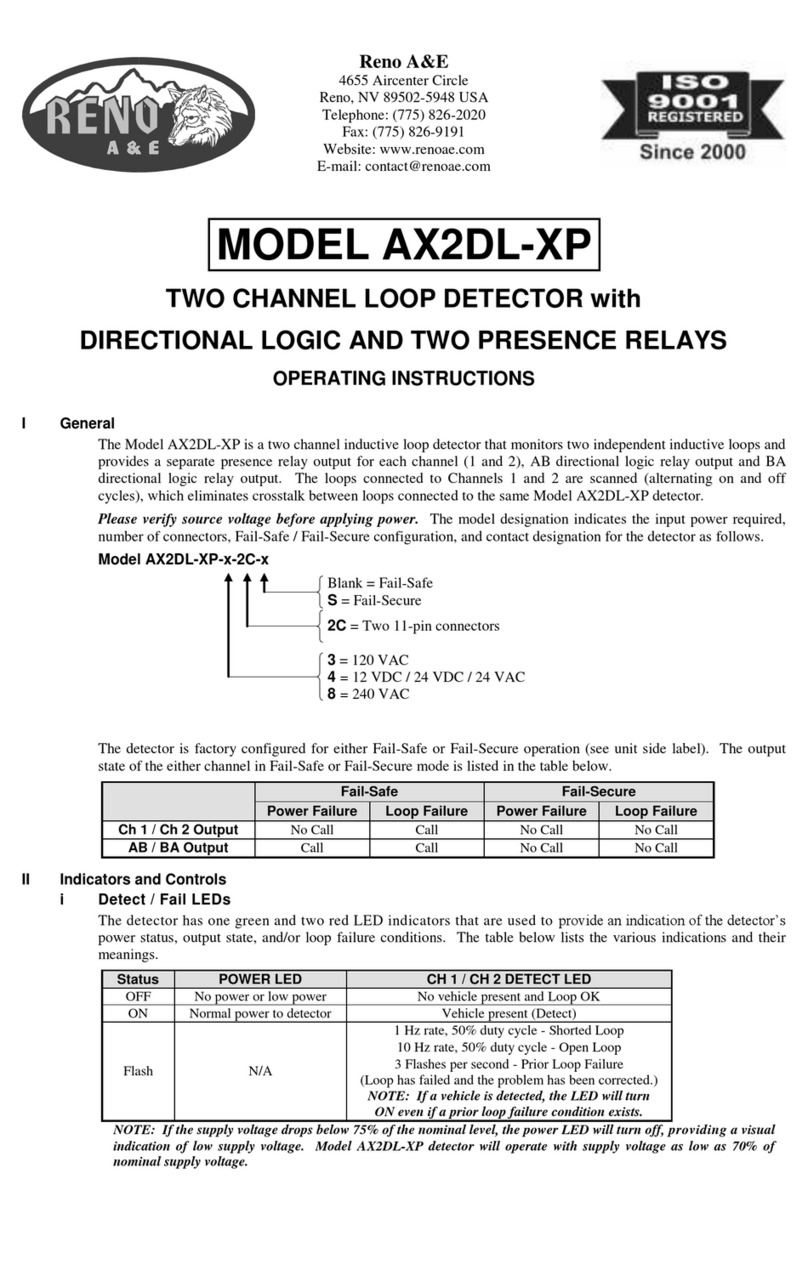2 3
Frequency (DIP Switches 1 and 2):
Loops connected to channels 1 and 2 of a Model AX2 detector cannot crosstalk (i.e. interfere with
each other). In situations where loop geometry forces loops to be located in close proximity to one
another and the loops are connected to different detectors, it may be necessary to select different
frequencies for each loop to avoid loop interference. DIP switches 1 and 2 can be used to configure
the detector to operate at one of four frequencies corresponding to Low, Medium / Low, Medium /
High, and High as shown in the table below.
NOTE: After changing any frequency switch setting(s), the detector must be reset by momentarily
changing one of the other switch positions or pressing the front panel RESET pushbutton.
Frequency
Switch Low (0) Medium / Low (1) Medium / High (2) High (3) *
1 ON OFF ON OFF *
2 ON ON OFF OFF *
* Factory default setting.
Presence / Pulse Mode (DIP Switch 3):
Each channel has two modes of operation, Presence or Pulse. When in Pulse mode (DIP switch 3
set to ON), a 250 millisecond pulse is output each time a vehicle enters the loop detection area.
When in Presence mode (DIP switch 3 set to OFF), the channel’s output operates in True
PresenceTM Mode and the detector channel will hold a Call output as long as a vehicle is present and
power is not removed or reset applied. True PresenceTM hold time applies only for normal size
automobiles and trucks and for normal size loops (approximately 12 ft2to 120 ft2).
Sensitivity Boost (DIP Switch 4):
DIP switch 4 can be turned ON to increase sensitivity during the detect period without changing the
sensitivity during the no detect period. The boost feature has the effect of temporarily increasing the
sensitivity setting by up to two levels. When a vehicle enters the loop, the detector automatically
boosts the sensitivity level. As soon as no vehicle is detected, the detector immediately returns to
the original sensitivity level. This feature is particularly useful in preventing dropouts during the
passage of high bed vehicles. The factory default setting is OFF (no Sensitivity Boost).
Sensitivity (DIP Switches 5 and 6):
Each channel has four (4) sensitivity levels. DIP switches 5 and 6 select one of the four sensitivity
levels available as shown in the table below. Use the lowest sensitivity setting that will consistently
detect the desired type(s) of vehicle(s) that must be detected. Do not use a sensitivity level higher
than necessary.
Sensitivity Level (-∆L/L)
Switch 0.32% (0) 0.16% (1) * 0.08% (2) 0.02% (3)
5 OFF ON * OFF ON
6 OFF OFF * ON ON
* Factory default setting.
III. Reset:
Pushing the front panel mounted pushbutton labeled RESET or changing any DIP switch position
(except 1 or 2) will reset the detector. After changing the frequency selection switches, the detector must
be reset.
IV. Power Down Memory:
When power is removed, the detector automatically remembers the status of the loop. During the loss of
power, vehicles may enter or leave the loop detection area. When power is restored, the detector will
correctly determine the current loop status and output a Call if a vehicle is in the loop detection area. If
the loop detection area is vacant, a Call will not be output. (A power loss power dip of any duration will
not bring a gate arm down onto cars as they wait at the gate). IMPORTANT: After installing and
applying power to the Model AX2 detector, momentarily push the RESET button to clear the
Power Down Memory. This initializes the detector to the loops that are connected and clears the
memory of any previous loop information.
V. Failed Loop Diagnostics:
Each channel’s DETECT LED indicates whether or not the loop connected to the channel is currently
within tolerance. If the loop is out of tolerance, the LED indicates whether the loop is shorted (one Hz
flash rate) or open (10 Hz flash rate). If and when the loop returns to within tolerance, the DETECT
LED will flash at a three flashes per second rate to indicate that an intermittent loop fault has occurred
and has been corrected. This flash rate will continue until another loop fault occurs, the detector is reset,
or power to the detector is interrupted. If a vehicle enters the loop detection area while the DETECT
LED is indicating an intermittent loop failure, the DETECT LED will turn on to indicate the presence of
the vehicle.
VI. Pin Connections:
Wire colors are for Reno A&E harnesses
Pin Wire Color Function
1
Black AC Line / DC +
2
White AC Neutral / DC Common
3
Orange Channel 1 Loop
4
Green Channel 1 Loop
5
Yellow Channel 2 Loop
6
Blue Channel 2 Loop
7
Gray Channel 2 Relay, Normally Open (N.O.)
8
Brown Channel 2 Relay, Common
9
Red No Connection
10
Violet, or
Black / White Channel 1 Relay, Normally Open (N.O.)
11
White /Green or
Red / White Channel 1 Relay, Common
VII. Warnings:
Separately, for each loop, a twisted pair should be created consisting of only two (2) loop wires running
the entire distance from the loop to the detector (including runs through all wiring harnesses) at a
minimum of six (6) complete twists per foot. For trouble free operation, it is highly recommended that
all connections (including crimped connectors) be soldered.





















